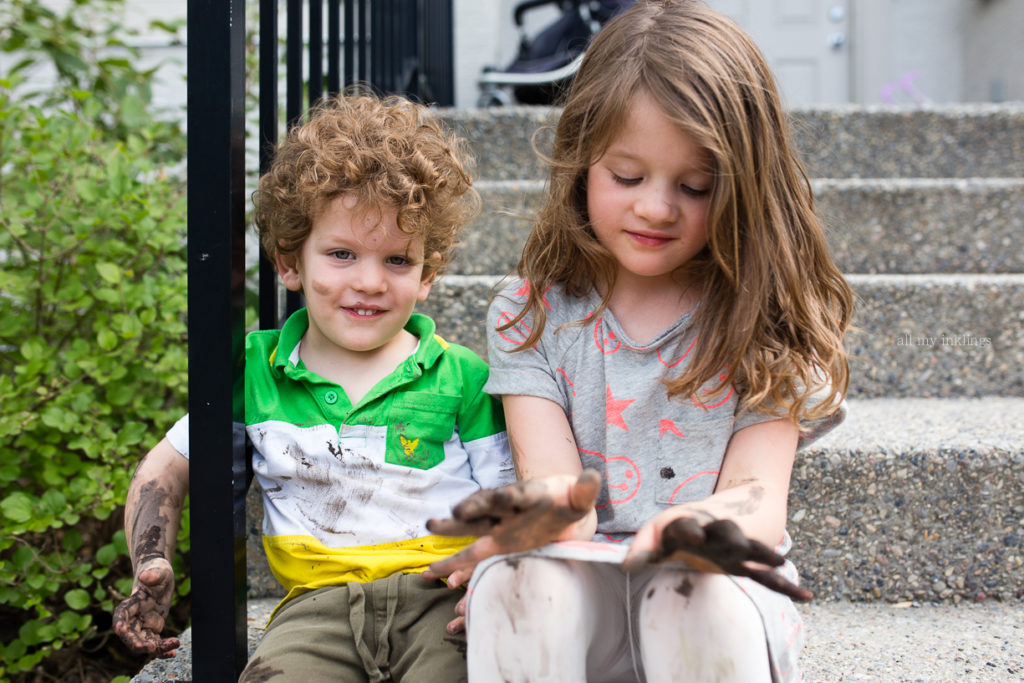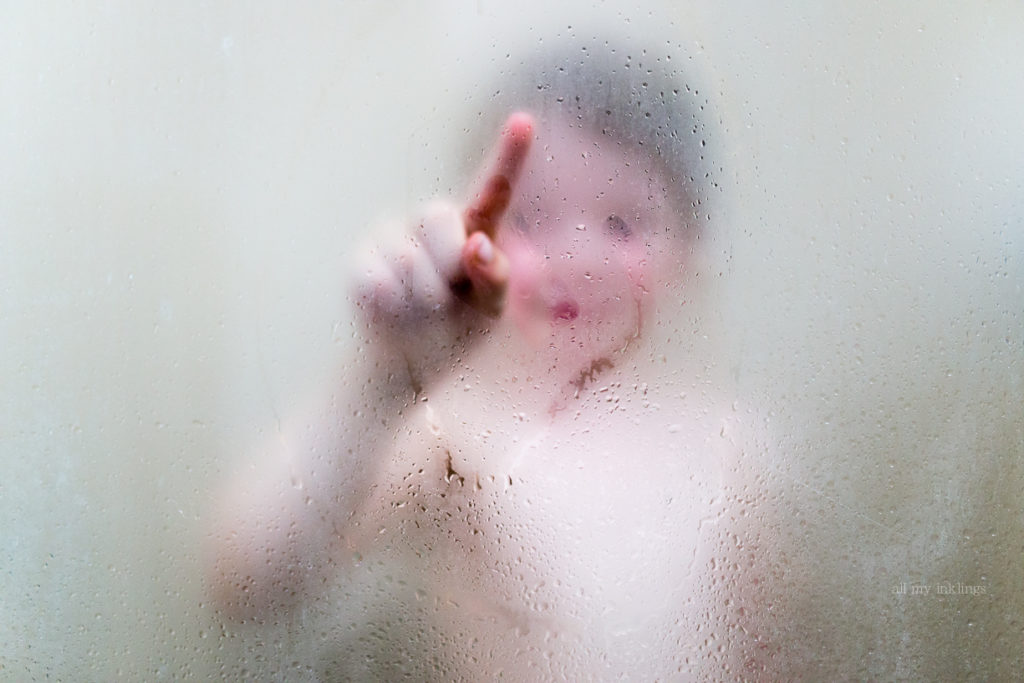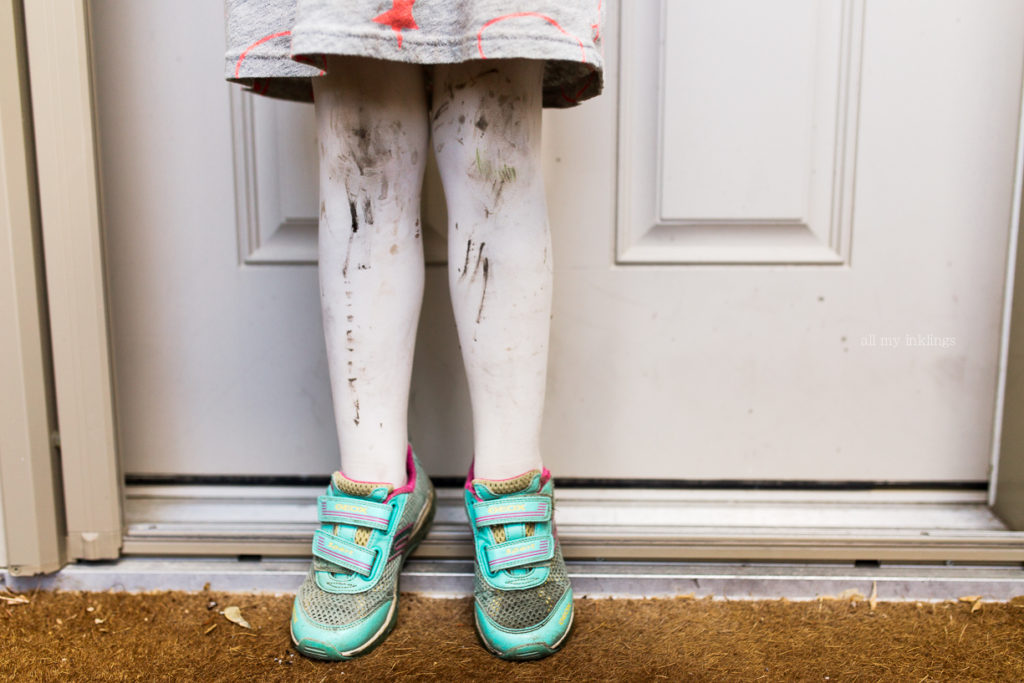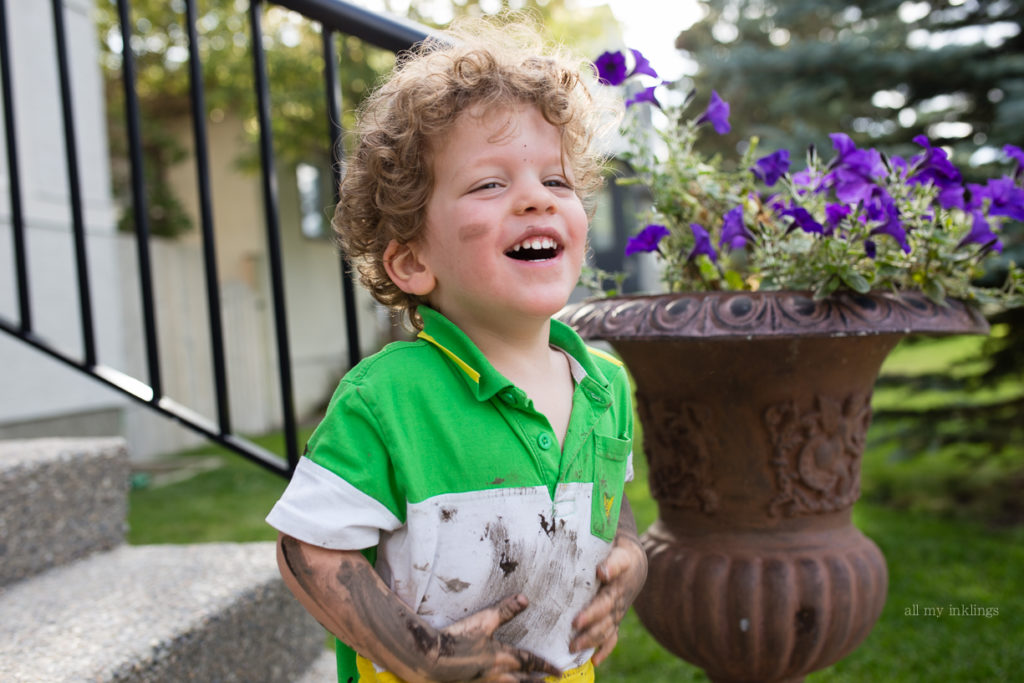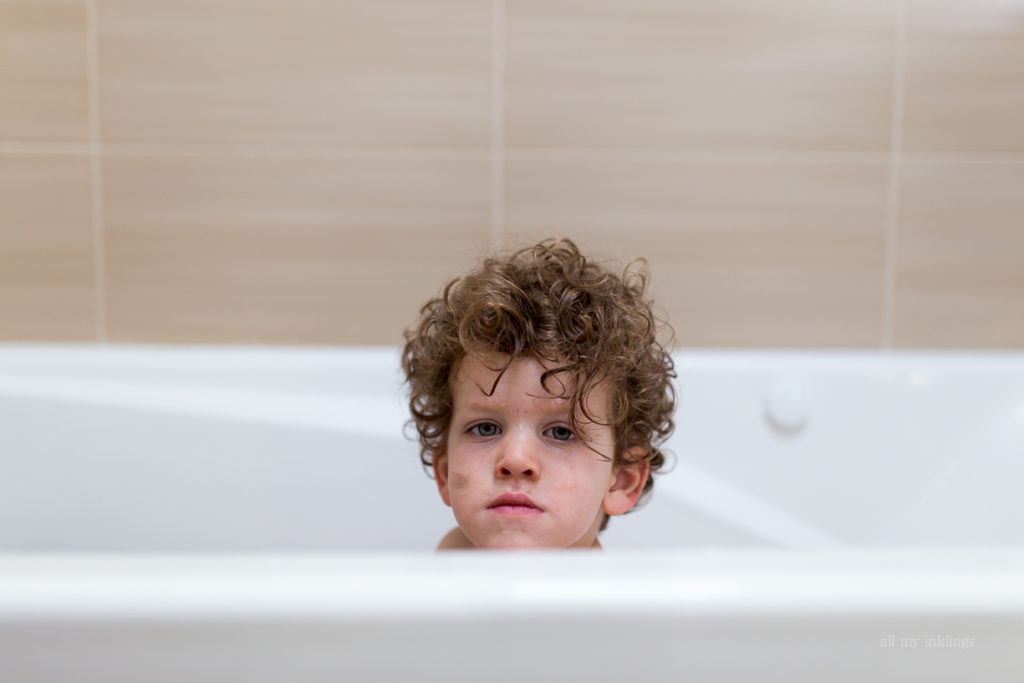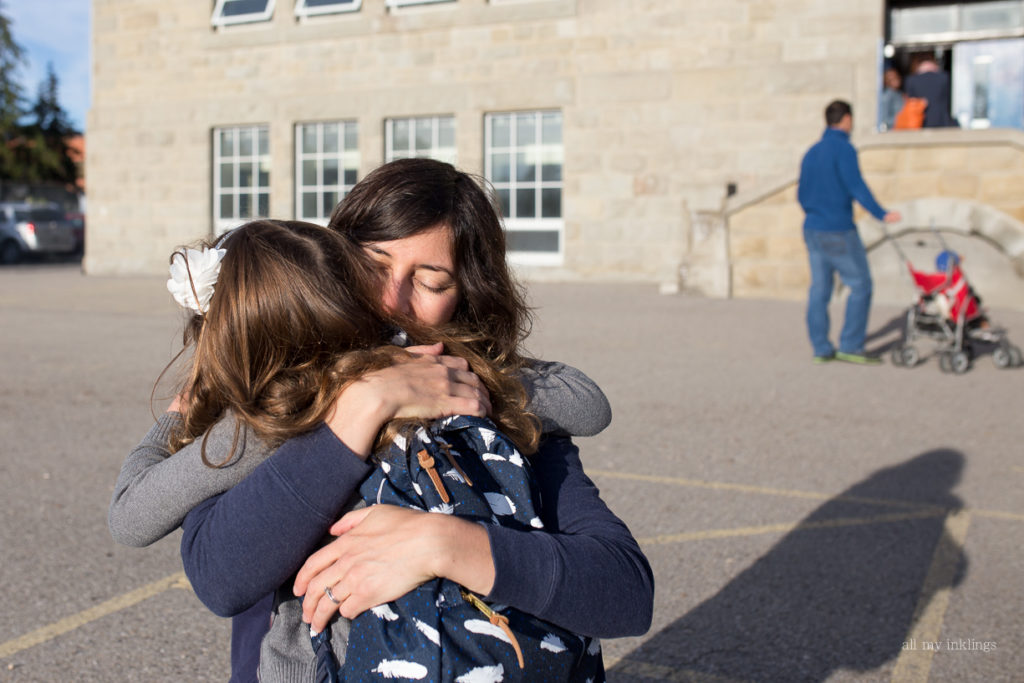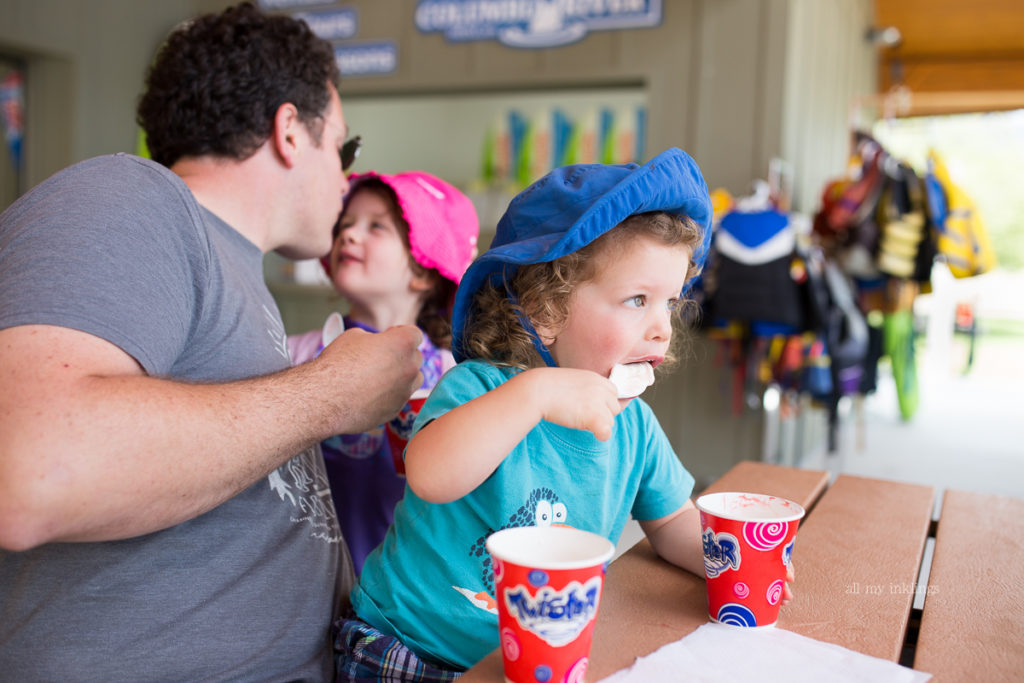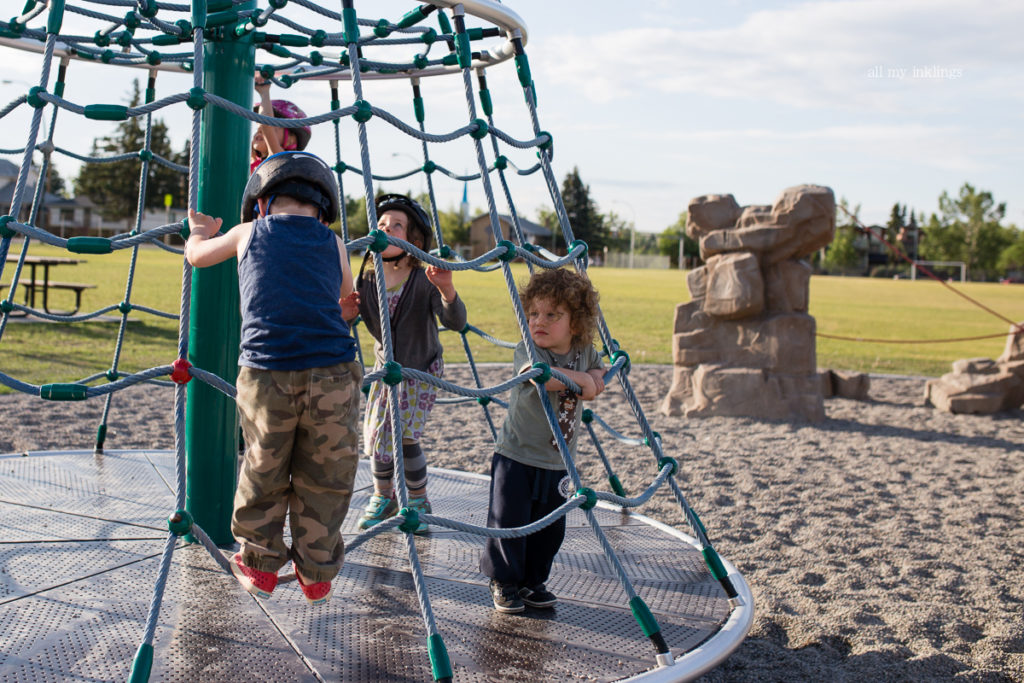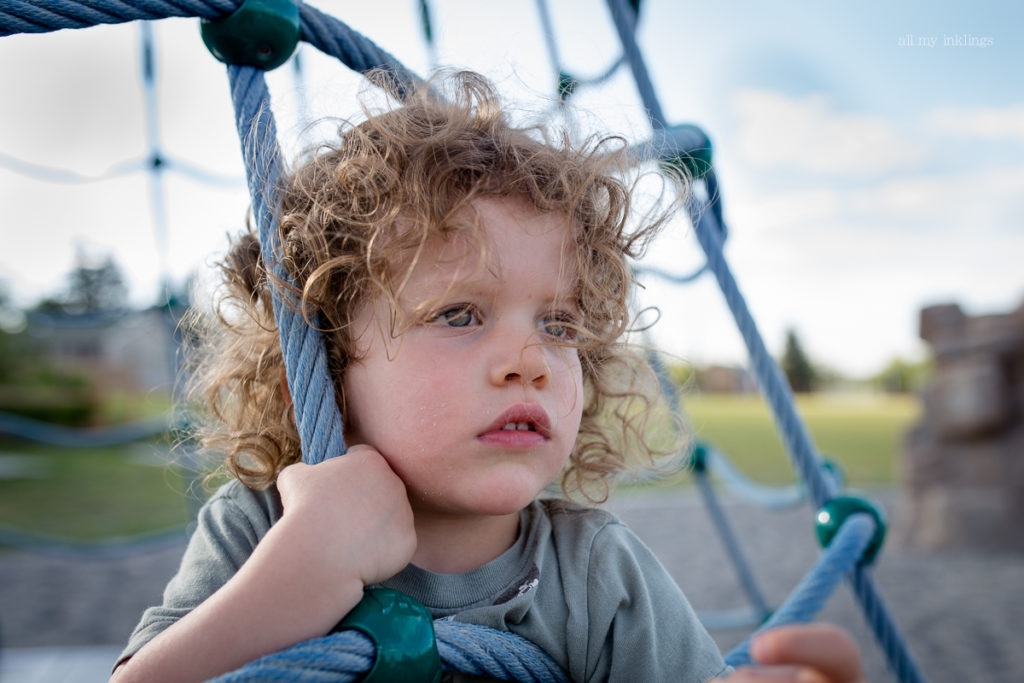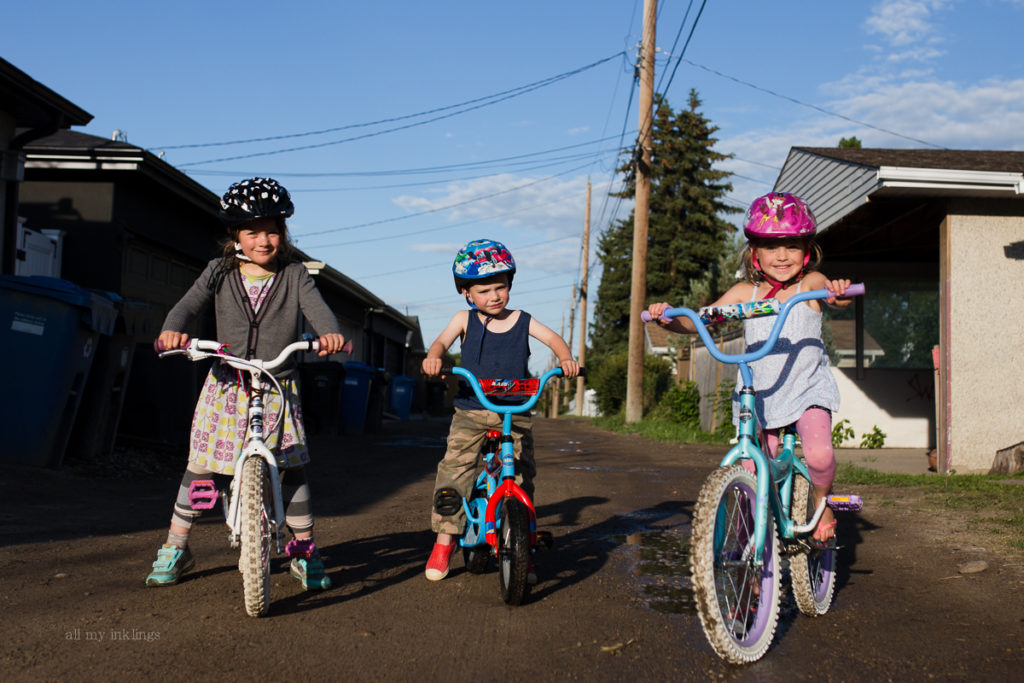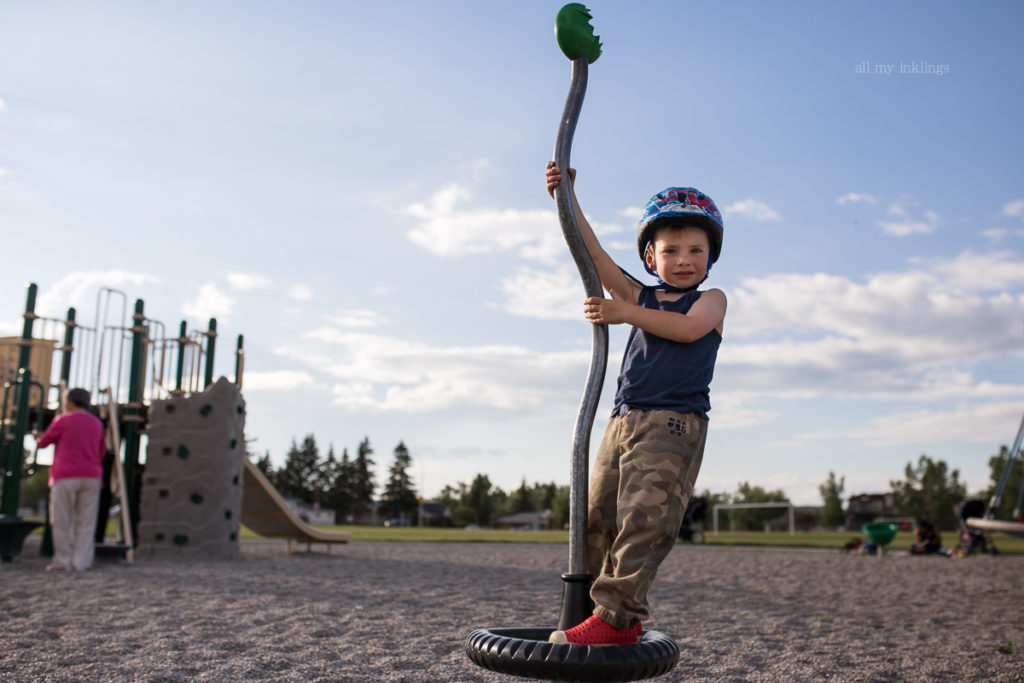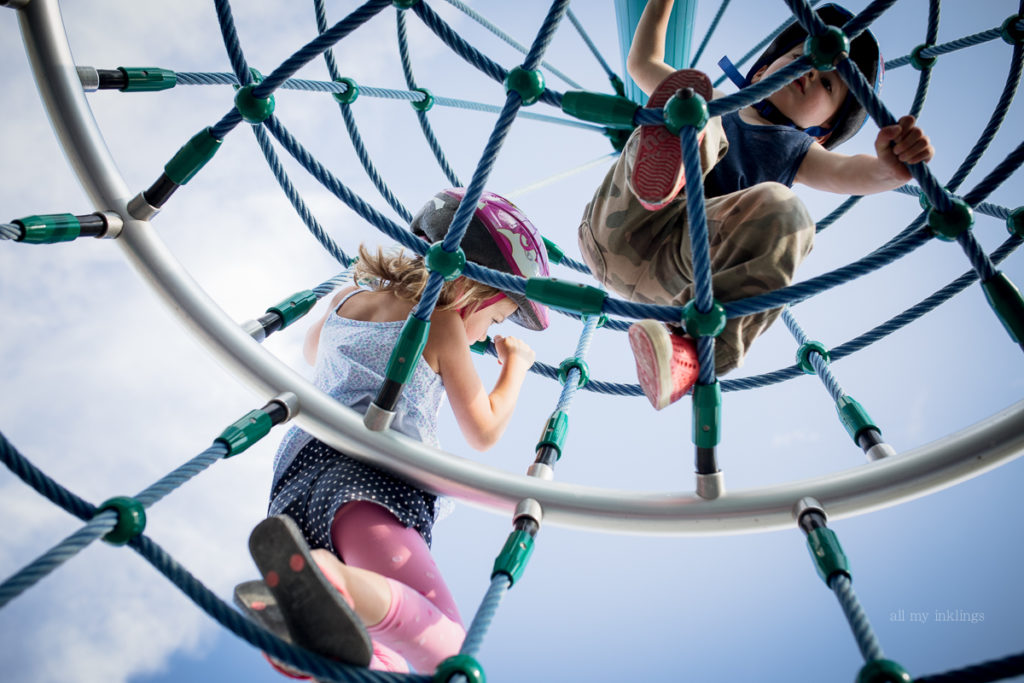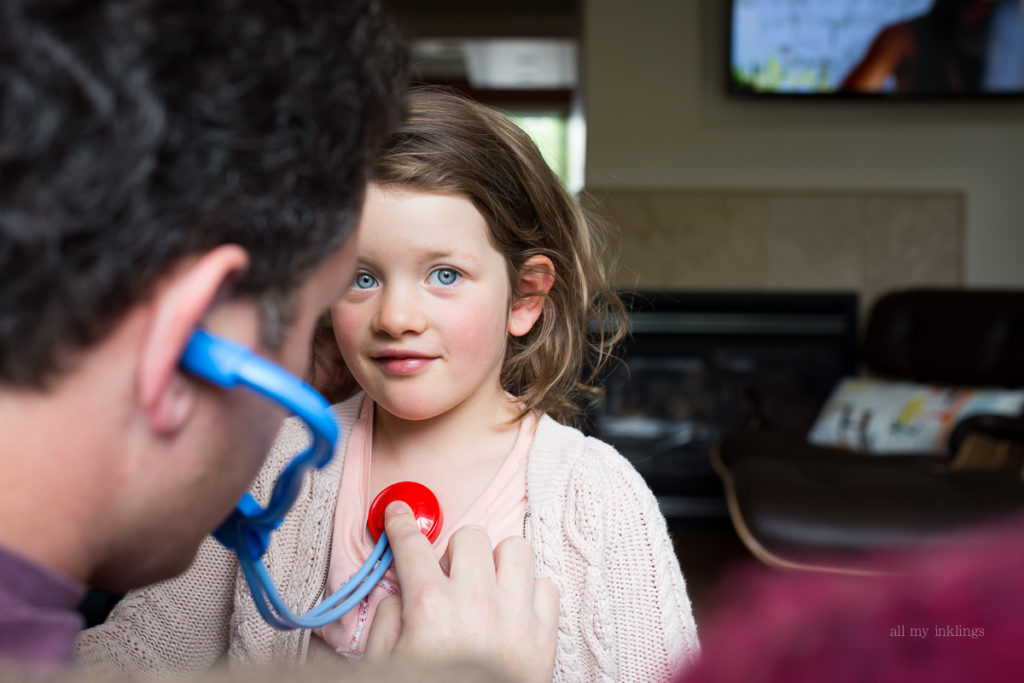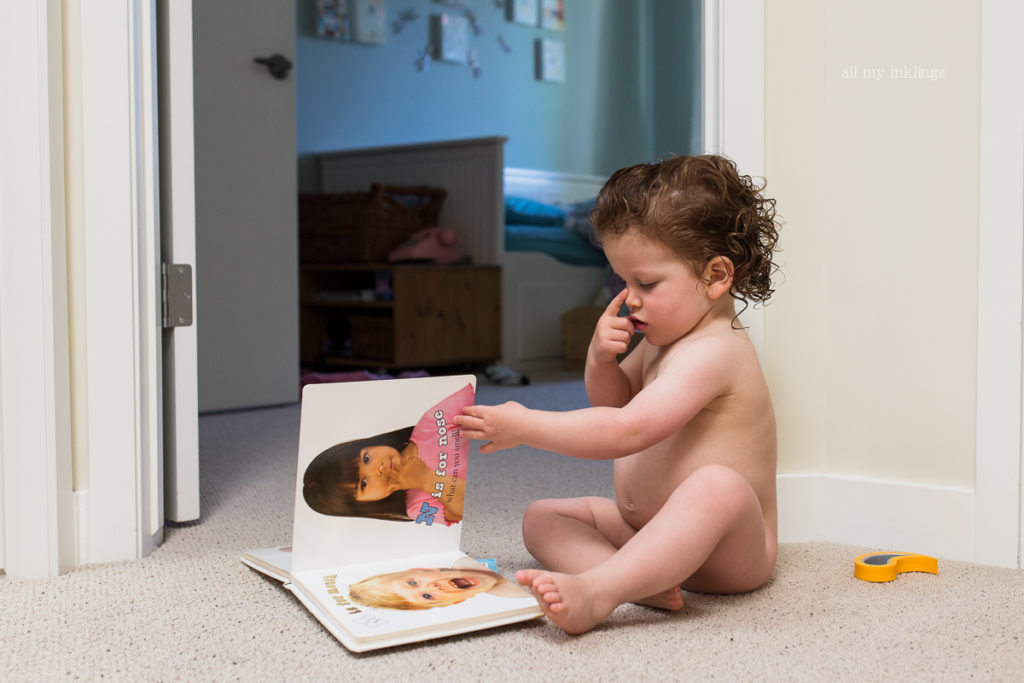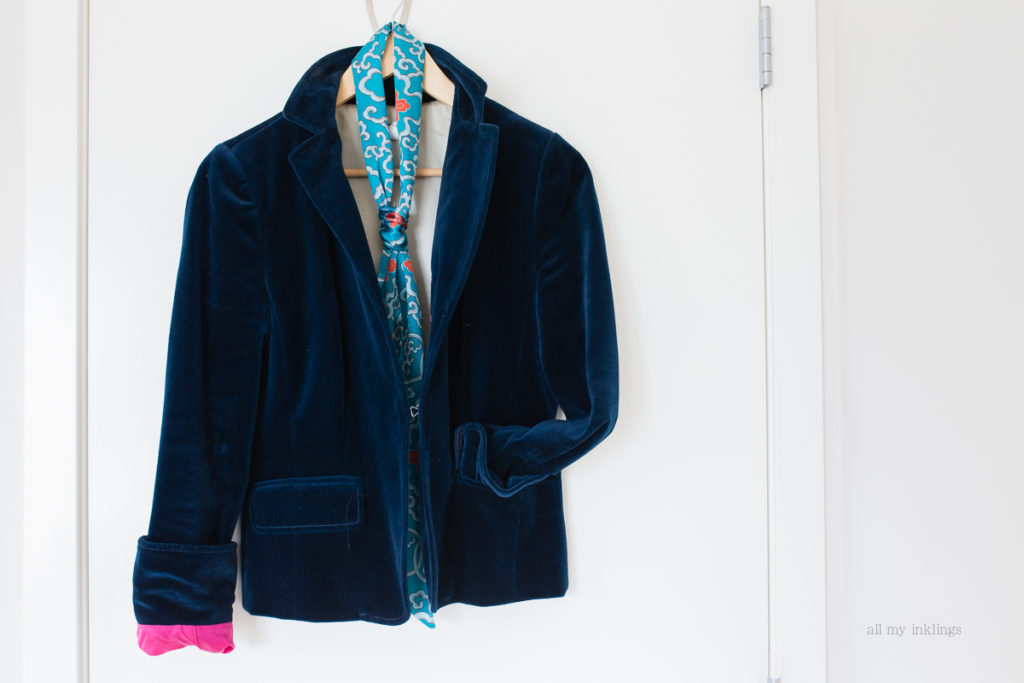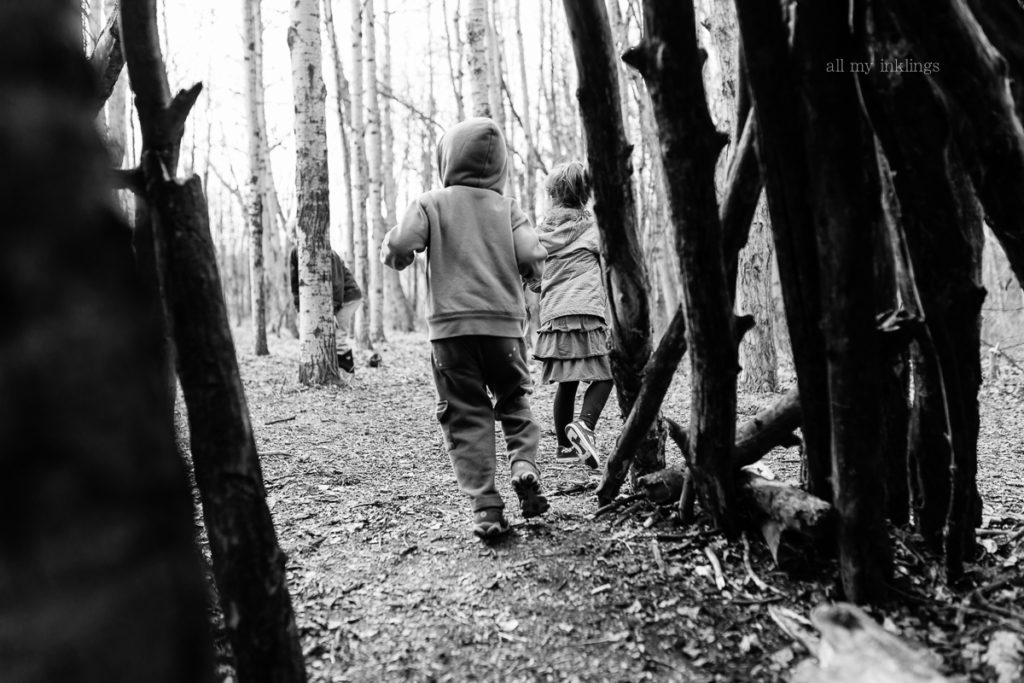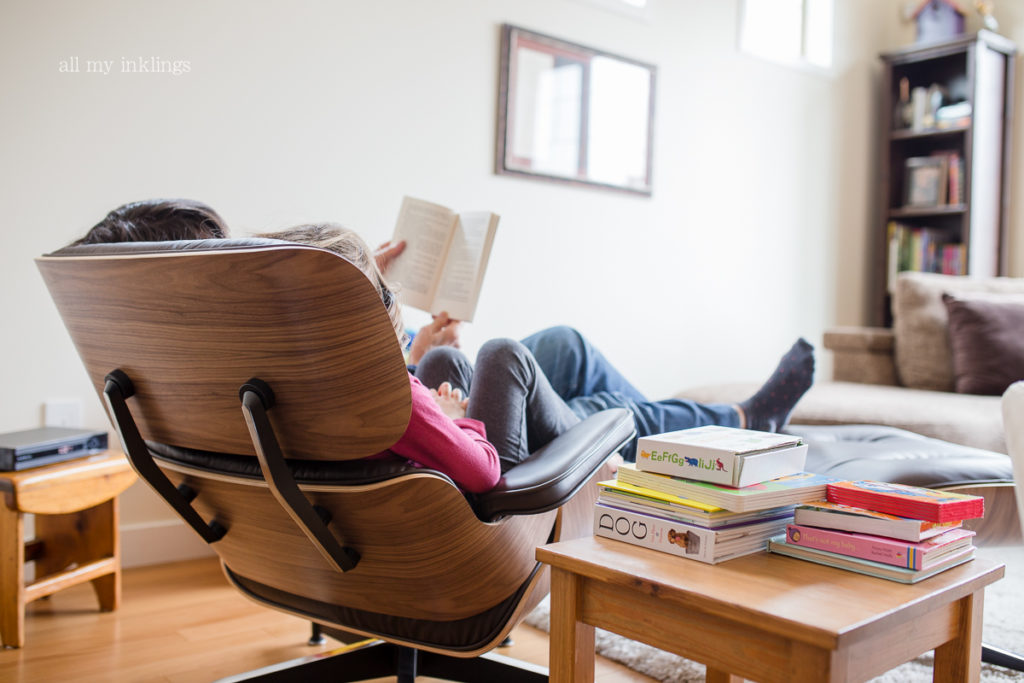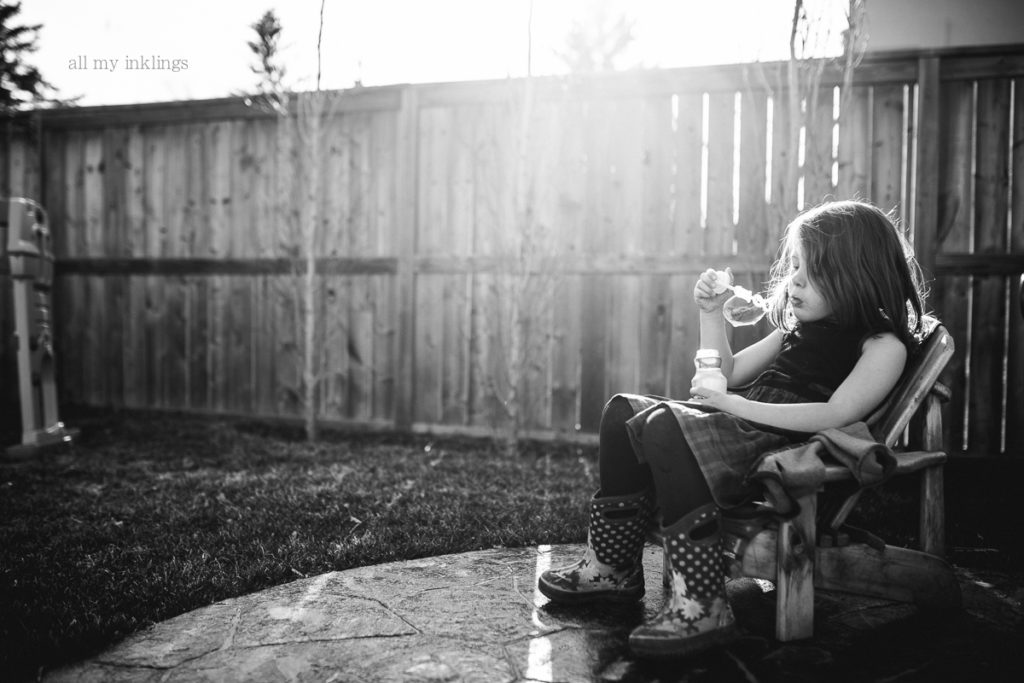Wake me up when September ends
 Kindergarten is the modern world’s dunk tank into cold, hard reality. One day, you’re sleeping til you’re done, eating a lazy breakfast, and getting dressed when the mood strikes. The next day you’re ripping yourself out of bed, being blinded by the rise of curtains and shovelling down food in an attempt to provide sustenance before the bell rings.
Kindergarten is the modern world’s dunk tank into cold, hard reality. One day, you’re sleeping til you’re done, eating a lazy breakfast, and getting dressed when the mood strikes. The next day you’re ripping yourself out of bed, being blinded by the rise of curtains and shovelling down food in an attempt to provide sustenance before the bell rings.
I’m sure it’s been tough for E, too.
After three hard weeks I’ve come to a startling conclusion: September kind of sucks. I had notions of sliding into a gloriously well-oiled routine after a summer of lackadaisical free-for-alls. Clothes would be chosen the night before. Bedtime would be easier (since she’d be tired from all that learnin’). Then we’d have a happy skip to school before she faced another exciting day of mind expansion.
That fantasy played out for the first few days. Then sometime in the middle of week two, E woke up and asked me how much longer she’d have to go to school. At first I thought the truth would be a hard blow but then I remembered she has no concept of time. I also realized that no matter what I said, it wouldn’t be the answer she wanted, which was likely something along the lines of, “just a few more days, babe.”
In the last few weeks she’s gone from excited to tired to annoyed. Now we’re at just plain pissy. And I’m here thinking, good gravy this is going to be a long thirteen years. Luckily, I know people who’ve been around the schoolyard a few times. I’m told everyone’s shit hits the fan near the end of September. The kids have caught on that this school business is an actual thing and it isn’t going away. Apparently, they lose their will to fight after Thanksgiving (the Canadian one).
(I’m sure there are exceptions. We all know those people whose social media feeds have us believing they’ve found the key to the perfect family life. No one yells, their kids do the dishes and everyone plays Jenga together on Friday nights.)
It also doesn’t help that E is convinced I’m the one who made school start at eight in the morning. What kind of crazy fool does she take me for? In a fit of irrationality, I tried to introduce reason to our conversation.
“How could I possibly be responsible for forcing hundreds of kids to be at school that early? More importantly, why would I ever do that??” I suppose I should be flattered by the reach she assumes of my power, although also concerned that she thinks I’m capable of such lunacy.
When her anger first started to rise, I wondered whether something bothersome was going on at school. Unfortunately getting pertinent information out of a five-year-old is like trying to get shoes on a two-year-old. Both are incredible frustrating activities that usually result in footwear being thrown across the room.
Then I found this list of great questions. I tried ones like, “did anyone do anything nice for you” and “who made you smile” but another thing about five-year-olds is that they have no concept of gratitude. I was asking these idyllic questions of the same child who, a week prior, cried over the future absence of ice cream while she was still eating the ice cream.
Last night, I took a different approach:
Who did you sit beside? Noah. If someone in your class could be the teacher, who would you want it to be? Me! What’s the hardest rule to follow? NO TALKING!!
Little by little, I’m shedding light on the mysteries that unfold behind those closed doors. In this respect, I’m happy Alberta has bucked the trend of subsidized daycare and kept kindergarten at a half-day. It gives us a bit more time to prepare for that day when they go off on their own, forget that we exist, and only call when they need money or advice about how to do laundry.
Day One
In the days leading up to this moment, all I could think about was how the hell I would ever get the Queen of Stall Tactics to school on time. I've been ruminating on that point since about May, back when we learned school would start at the ungodly hour of eight o'clock in the morning. I imagine it was my brain's way of creating a diversion from the actual task at hand: letting go.
Friends had told me how they melted into puddles of tears the first day their little one marched off to school. I couldn't imagine why. It's not like we're shipping them off to boarding school. It's kindergarten. It's less than three hours long. You can't even do Costco in that time.
Then it was my turn. Luke stayed home late that morning to help get everyone out the door on time. As I mentioned, I was worried I would be dragging a half-dressed, underfed fit of defiance to the school yard to greet the new teacher. On this day, she was standing by the side of the bed, fully dressed and raring to go before I had both eyes open. Excitement, fear, nerves, whatever we were working with, it certainly made my life easier.
It all seemed rather idyllic. We walked hand in hand in hand, the three of us, towards the schoolyard we know so well. She has spent many an afternoon exploring its playground or running through the field. It's where she learned to ride a bike and where she flew a kite for the first time. Despite my agonizing over school options, I think we always knew she'd some day join them on the inside.
The teachers stood outside in front of the swarm of nerves. Parents and children alike staring silently as they waited for a name to be called. Some ran to stand in line without looking back. Some ran the other way. All of them with their massive, snack-filled backpacks smacking the backs of their knees.
E had a few last minute tears, then walked up the steps and disappeared. All of a sudden, it was just the parents, standing there watching the doors close behind kids that two minutes ago were taking their first steps, saying their first words or eating a grape for the first time without it needing to be cut into a million pieces.
How the hell did that happen so fast? Why the hell did I want it to? Now it's all coming crashing down around me, all this time that I can't get back, and I finally empathize with the ugly cry set. We're not sad that they're growing up (we all talk about how wonderful it will be when they can get their own lunch or walk to a friend's house without a secret service detail), we're sad that they're doing it at the speed of light.
We're sad that with each new milestone, the previous ones seem to fade in our memories. We long for the feeling of their baby soft skin sleeping against our chest, for the fuzz of their hair tickling our nose, for the squeak of their voice as they learn how it works. We long for them to be small and vulnerable and close just a little while longer. Then they let go of our hand and walk away.
Summer à la mode
Summer is for throwing bedtime routines out the window
Summer
Everything
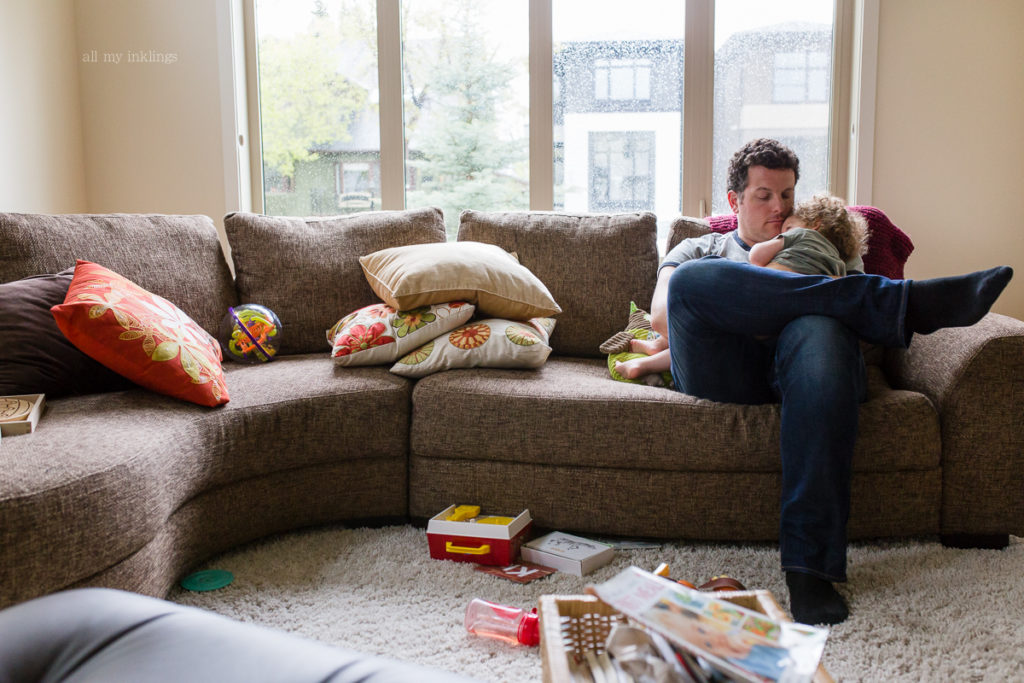 There is something intoxicating about photographs of Luke cuddling our babies. I could look at them for hours. Perhaps it's that I know how comforting and empowering his embrace can be, housing strength, love and protection all in the space between his arms and their tiny little bodies.
There is something intoxicating about photographs of Luke cuddling our babies. I could look at them for hours. Perhaps it's that I know how comforting and empowering his embrace can be, housing strength, love and protection all in the space between his arms and their tiny little bodies.
Wisely, these children yearn to be close to him, sometimes descending to such unloving acts as pushing and shoving in order to get the best seat. When he is away, or even if he has a few late nights at work, they start to wilt like cut flowers in need of fresh water. As far as children goes, this can mean becoming either incredibly sensitive or downright cranky. The only antidote is a swift reunion.
Sometimes I wish I could clone myself (I imagine every parent does, but in this instance I mean for reasons other than having someone else make dinner and change diapers) in order to capture similar moments shared with me. I'll be sitting on the bed braiding hair or holding a tiny hand as the blender makes its unsettling racket and I will take a snap shot in my mind. Like many photographer parents, I not only want my children to have beautiful memories of their youth, but to have evidence that I was part of it.
I have experimented with taking my own photograph, but often it feels weird. The idea behind candid or documentary photography, or whatever catch phrase is used for capturing real life, is that it isn't contrived. In theory, we shouldn't move water bottles out of the way to get a clean shot or ask someone to repeat their actions under better light. I'm struggling to decide how balancing a camera on a stack of cookbooks in order to capture a manufactured moment fits into all of that. It's not like this scene hadn't played itself out a thousand times over. It's just that this time, I made sure the camera was there.
I guess we can leave it at this: if you happen to see a photograph with me in the scene, it's likely a set up (this was an exception). Same goes for anything involving clean children sitting nicely and looking like angels. Everything else is as real as it gets.
Listen
Thinking
Rock on, sister
N is for nose
Life lessons in a closet full of no
My muse has been taking a breather. It seems to know I don’t have time for nagging creative thoughts. I have work to do.
You see, I am currently balls deep in a massive household purge. I’m not talking the kind where I toss a few shirts that no longer fit my continually-morphing post-gestational body. This one is going to the very core of my existence: the past, the future, my guilt, hopes and regrets.
I’ve seen a lot written recently about why we keep what we do and the troubles we have parting with possessions from our the past. Purging is floating in the current stream of our Jungian consciousness. Even Elizabeth Gilbert is preaching the value of minimalism.
I know it is a typical activity for Spring, but this year feels a bit more intense, as though people are starting to realize that, deep down, what we own defines who we are. Stripping down the layers of our belongings carves away at our misconceptions. It forces us to be harsh about our truth. Am I the kind of person who can throw out a gift someone gave me twenty years ago? What about last week? If I say yes, does that make me unsentimental, insensitive and ungrateful or will they understand the gift’s exit from my household is not an indiction of my respect for their friendship?
I have been feeling lately that our belongings are smothering me. We live in a decent sized house and, upon first glance, you might not think it’s filled to the brim with crap. As with many things in life, I learned to hide it well. Cupboards help. Storage rooms, too. But deep down, I know it’s all there, hiding like a stowaway hoping to never be seen.
It’s as though the possessions themselves don’t want to be tossed. I find this to be especially true of dolls and stuffed animals. Even as a 39-year-old woman, I feel heartless putting a collection of fabric, stuffing and googly eyes into the trash. I have always had this problem, which is probably why my childhood dolls—one of whom looks like Chucky’s bride—are still kicking around.
As I muddle through this process, I admit I grow weary from the constant stream of decisions. Last week’s challenge was cookbooks, which are akin to religious teachings. Today, I found the box where I kept all our (ahem, MY) wedding plans and ideas, including about 30 extra invitations. I can understand keeping one, but 30? I have also found floppy disks and cassette tapes from when work involved microphones and interviews, quilting projects I started five years ago (i.e., before children), and of course, clothes that defy fashionistic sense.
Strangely, some of the hardest items to part with have been work clothes. If I were to hazard a guess why, it would be because I hate shopping for them. I love the look of beautiful clothing, just not on me. This is not meant to be self-deprecating. I just have always felt awkward and uncomfortable in nice clothes. I am also notoriously bad at coordinating shoes and accessories and my inexperience shines through with every shift of my belt.
I remember once as a kid deciding to surprise my mother by showing up at church despite the fact she had clearly given me a get-out-of-Jesus pass that day. Unsure what to wear, I turned to the only outfit I knew: my school uniform. I can still remember the look of horror as she caught sight of me marching towards God with my green and yellow tie fashioned around my neck in a bow. I may have even had my button-down shirt tied like a crop top at the waist. It wouldn’t surprise me.
Perhaps this is one of the reasons why I became a journalist, a profession that punishes people for wearing skirts by sending them on assignment to a wind farm. For many years, I escaped dress pants and heels by claiming it was better for business. But for a short time after journalism, I worked where women wear stockings. I ended up having to keep a steady supply in my desk. Without fail, no matter how expensive they were, I would have a run from heel to knee before the mid-morning coffee break. If I took them off, then my panty line would show. I struggled for nine months to understand how people get anything done when they’re worried about visible underwear or breaking an ankle walking down the hall. I stocked it up to experience, of which I had very little.
But here I am, however many years later, staring professional-looking dresses and packs of nylons in the face. For some strange reason, I’m having trouble letting them go. I can’t see myself working a fancy-clothing-office-job anytime soon yet half the allotted space for my newly decimated wardrobe holds clothing more suited for board meetings than flying food.
I even have one jacket that reminds me of Austin Powers. Why on earth would I keep something that makes me want to yell, “Who does Number Two work for,” every time I see it?
A friend wisely pointed out that if I ever do go back to an office job, all these clothes will be horribly out of style (if they weren’t to begin with). Wide-legged trousers, sweater vests, pouffy-sleeved things that pointed out my failings in femininity. Perhaps I view tossing them as evidence of poor decision-making in my past or as a sad commentary on the potential of my current aspirations. What do I say to the world about my perceived future if all I keep are ripped jeans and hoodies I bought at the grocery store?
As you can see, this process is taking me beyond reason and material goods. It must be that struggling to say goodbye to nylons and velour blazers is training for the greater challenge that will come when I get to the basement. That is where I’ll find photographs from when photographs were physical objects, souvenirs from when adventures were taken, and the trunk that holds every last remaining element of my childhood. If I’m this philosophical about clothing, imagine how I’ll be when I start reading my report cards. Maybe I’ll discover the meaning of life in the midst of all that musty paper. Either that, or a lonely stuffed animal who needs a good hug.
Almost
 Sometimes I get to thinking it would serve me well to have more direction in life. Much of my existence follows the take-it-as-it-comes philosophy. It keeps me on my toes but lacks any real push towards meaningful accomplishment. Yes, I did cleaned the kitchen for the gazillionth time but does that really count as having *done* anything? It isn't something I'm eager to include in the post mortem of my day, though (somedays) if I didn't, it would seem I did nothing but romance the pooch.
Sometimes I get to thinking it would serve me well to have more direction in life. Much of my existence follows the take-it-as-it-comes philosophy. It keeps me on my toes but lacks any real push towards meaningful accomplishment. Yes, I did cleaned the kitchen for the gazillionth time but does that really count as having *done* anything? It isn't something I'm eager to include in the post mortem of my day, though (somedays) if I didn't, it would seem I did nothing but romance the pooch.
Maybe that's why so many mothers start their own websites, whether they be about food, photography, writing or, well, whatever else people muse about. We are the elastic bands in our families. Whenever something out of the ordinary happens, we stretch to accommodate the extra need. It's wonderful to know there is always someone available to fight the fires without disturbing the other person's professional pursuits, but it also means you always have to be ready to drop everything at a moment's notice. After a while, you start to think things like "big projects" are a pointless endeavour because you will inevitably be interrupted and called upon to manage two weeks worth of illness. Having a website ensures you at least have your own little corner of the Internet that isn't going to get angry if you miss a deadline.
This is all sounding very depressing. I'm just in a reflective mood. I was thinking back to a photography course I took last fall through ClickinMoms. The course, taught by the eternally giving and insightful Meredith Askey Novario, aimed to teach us how to tell a story in just one frame. At the end of four weeks of intense introspection and experimentation, we were asked to come up with a project that we could see ourselves carrying forward through our photographic journey. I was stumped. I decided to go with something totally easy: the overhead view.
I'm being sarcastic here. Shooting from above requires one to be tall enough to get above your subject and be far enough above them that your lens will focus. It's great if you want to photograph ants, for example. People? Not so much. My classmates and I were joking that I would need to start including a stepladder in my kit bag. I was going to title the project, "Mom, what are you doing up there?"
(I will admit that sometimes I cheat by holding the camera up in the air and praying for good fortune. It always reminds me of a scene from Austin Powers when I do that. Sometimes it works. Most of the time it doesn't.)
I haven't been doing a very good job of keeping up on this overhead project, partially because of the challenges the technique presents to someone who's only 5'6" (on a good day). But as I was scanning my mind for an appropriate caption to the photograph at the top of this post, it suddenly dawned on me: I might have more success if I embrace an abstract notion rather than a predetermined vantage point. And so I came up with Almost.
So much of life with kids is about watching them try and try and try while fighting the urge to jump in and do it for them (though sometimes this is necessary if one is to arrive anywhere even remotely on time). It is the living version of the Butterfly's Struggle. It's about shoes on the wrong feet, shirts on backwards, standing on tippy toes, mispronouncing spaghetti, the backwards E on their cards. We want them to succeed but at the same time we don't, since that would mean they've grown once again.
There will always be almosts. Maybe this will be the true way to reflect back on their lives, one struggle at a time, one accomplishment almost realized.
The Cult of Personality
Someone once suggested that I’d know I was truly grown up when I became the same person around my parents as I am around my friends. I’m not sure why this was deemed to be a barometer of maturity. Frankly, I'm not sure any of us want to go through life being the same person at every turn.
I had an interesting revelation along these lines in the not so distant past. I noticed that my voice tends to jump an octave in certain situations, like when I’m ordering in a restaurant or calling an appliance repair shop. I fully understand why—all the women in my immediate family do the same thing—but the fact that I do drives me bananas. It’s as though I’m saying my regular voice, which is a bit smarmy, isn’t feminine enough for mass consumption. I go overkill on the pleasantness, leaving the other person thinking they're talking to a delusional housewife who’s been a bit too liberal with the quaaludes (or whatever be the modern equivalent).
I remember reading an article once about how babies enjoy our playing the part of babbling idiots. It was something about the higher pitch resonating a vibe of happiness in their new little brains. By the same token, they also enjoy the deeper tones Dad provides, likely because that voice sounds a bit more relaxed than Mom’s overly enthusiastic attempts to get a smile. In my own experience, I notice a happier, sing-songy voice when trying to sway my toddler’s opinion, a somewhat less annoying tone when speaking to my four-year-old, and an arguably tired and grumpy voice when speaking to my poor husband. Sorry Luke.
It reminds me of another article a based on a book co-authored by Elizabeth Dunn. The book is actually about how to spend money more happily (apparently this is challenging), but in it she suggests we should all try to treat our partners a bit more like strangers. Think about it. If you are in a similar situation to me, your significant other comes home around the time your children are turning into gremlins because you either haven’t yet presented them with dinner or you had the gaul to give them something other than hot dogs and cheese pizza. You’re not at your best. You’re not feeling the love. So they walk in the door and you’re thinking, “For the love of god, make the screaming stop!” as a dinner roll goes flying across the room and they're thinking, “Uh… hi?”
But let’s say they brought someone you’d never met home for dinner. Social etiquette makes it challenging to embrace anger when there’s a new person around. It feels as natural as wearing your underwear on the outside of your pants. So you’d probably laugh off the insanity, greet your guest and put on your best show. Eventually, you'd likely forget that you're supposed to be angry and end up having a good time.
It would be interesting to know at what age we start to experiment with these different masks and whether it’s even a conscious undertaking. Most of us don’t have a personality switch we actively flip depending on who walks through the door, it just seems to happen like a pavlovian response. If it is even possible to reach that plateau of full growth (god, I hope not), perhaps it's not through being the same person with our parents as we are with our friends or with our spouse as are with our children, but through recognizing the difference and understanding the manifestations.
Hair today
The Witches
Free to be
There’s been a lot of talk in recent days about showing girls the value of personal authenticity—that the best version of themselves is the one they are to themselves, likely when they think no one else is watching, and that being a little rough around the edges is better than feeling like you have to pretend you aren’t. At least, that’s the message I’m taking from the viral sensation that is Kate T. Parker’s photographic series, “Strong is the new pretty.”
From what I’ve read, part of the reason behind Parker’s project was a desire to show her girls they don’t have to be the picture of magazine perfection to be valued. Parents might also heed that advice, since they are the ones entering kids in cover photo contests or having people vote for their baby to be deemed the cutest in order to win a year’s supply of god-knows-what.
It’s a wonderful message for us all to hear, but part of me also thought, “how sad are we that the concept of encouraging our girls to be true to themselves is so novel, it garners the attention of the Today Show and CNN?” Then I remember how far society is from understanding things like equality, respect, and individuality. Group think is safe. Different is scary.
It reminds me a little bit of Tracey Spicer’s TEDx talk. I encourage you to watch this brilliantly engaging woman break down the cumbersome daily ritual that takes her from a frizzy-haired, fair blond with a less-than-perfeclty flat stomach (i.e., one that has housed babies), to a culturally acceptable, coifed, tucked and tanned TV host. At one point, she talks about the trouble she has explaining the point of this song and dance to her young daughter. What does it say to our kids when they see us painting our nails, straightening our hair or putting on various forms of face goop? We say, “Be yourself! You’re perfect!” Then we show them how we feel the exact opposite about ourselves.
So perhaps, by the same vein, photography is best platform to expose people to a different form of “perfect little girl.” After all, we see before we hear. This I learned during my brief stray from radio into the world of television news. You can have an amazing story, but if you don’t have pictures, you ain’t got shit. If Parker’s story is that her kids are amazingly real and unique characters worthy of celebration, there is no better way to prove it than to for her to show not tell.
As someone newly-smitten with the art of photography, I took something else away from all this. It’s a similar message, but one directed at me, not my kids. It’s that, as a photographer, it’s okay to do your own thing. I’m not sure what I’ve been aiming for recently, but I’m often crippled by the idea that actual photographers will look at my work and think, “I hope she doesn’t think she knows what she’s doing because x, y, and z are all wrong.” I struggle with the notion that there is a right and wrong and that there are little details I can’t see that give my ignorance away.
Then I see a series like this and I am struck by the variety, the freedom and the pushing of envelopes. The images are divine. They inspire me to experiment with scene, perspective and composition but also with the aftermath. Some of her photographs look like screenshots from a Wes Anderson movie, speaking to me from a land caught between truth and fantastical. Seeing something like this, I realize a good photograph isn’t just what I see through the lens, it’s also what I see through my imagination. If I play around with it, maybe people will catch a glimpse into that crazy world inside my head.
I’m not saying I don’t have more to learn (if we compare my photographic journey to climbing Everest, I haven't even bought my ticket to Nepal). I’m just saying it’s okay to play around and be flawed in the process. I’m pretty sure that’s the message Parker is trying to convey to her kids. She just probably didn’t realize it was a lesson the rest of us could take to heart.

